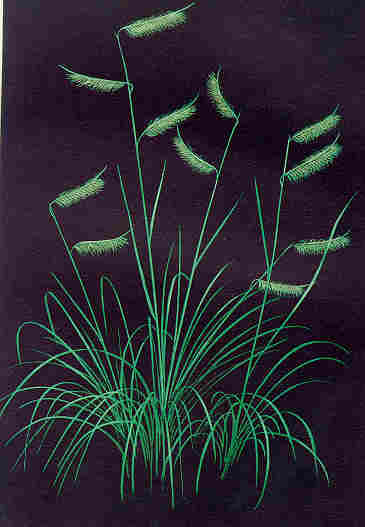

Hairy
Grama
Boutelo˙a
hirs˙ta
 |
|
Hairy grama is a native, warm-season, perennial, short grass that grows from 10 to 18 inches in height. It is a tufted bunchgrass with slender stems that spread or bow-out near its base. The basal leaves are hairy on the edges and upper surface, narrow and 3 to 5 inches long. The leaf sheaths are hairy and the seed heads, usually tow, rooster comb-like spikes are borne on the leafless flower stalks. The seed spikes, covered with hair, and curved and end in prominent needle-like points. (See illustration above) Hairy grama is found throughout the Great Plains - Wisconsin and North Dakota, south to Texas and west to Colorado and Arizona. It grows on shallow, sandy or rocky sites and is adapted to most soils regardless of acidity or alkalinity. This warm-season grass is one of the most nutritious of the grama grasses and is readily eaten by all classes of livestock. Hairy grama is an increase on tall grass ranges that are abused by overgrazing. It is never found on large areas as a pure stand. It can be harvested with a combine and is easily established from seed or seed hay that is mowed and scattered immediately on the area to be seeded. All species of Boutelo˙a are native to the Western Hemisphere and about 18 occur in the United States. These are represented throughout the Western States and Great Plains and are reliable producers of good forage on range and pasture land. The grams are summer growers and the amount of forage they produce depends upon the moisture available during the growing season. In years of extreme drought, they make little or no new top growth. Most species cure naturally; standing growth from previous seasons is palatable and provides satisfactory forage for most classes of livestock. Portions copyright "Pasture and Range Plants", Phillips Petroleum Company, 1963 |